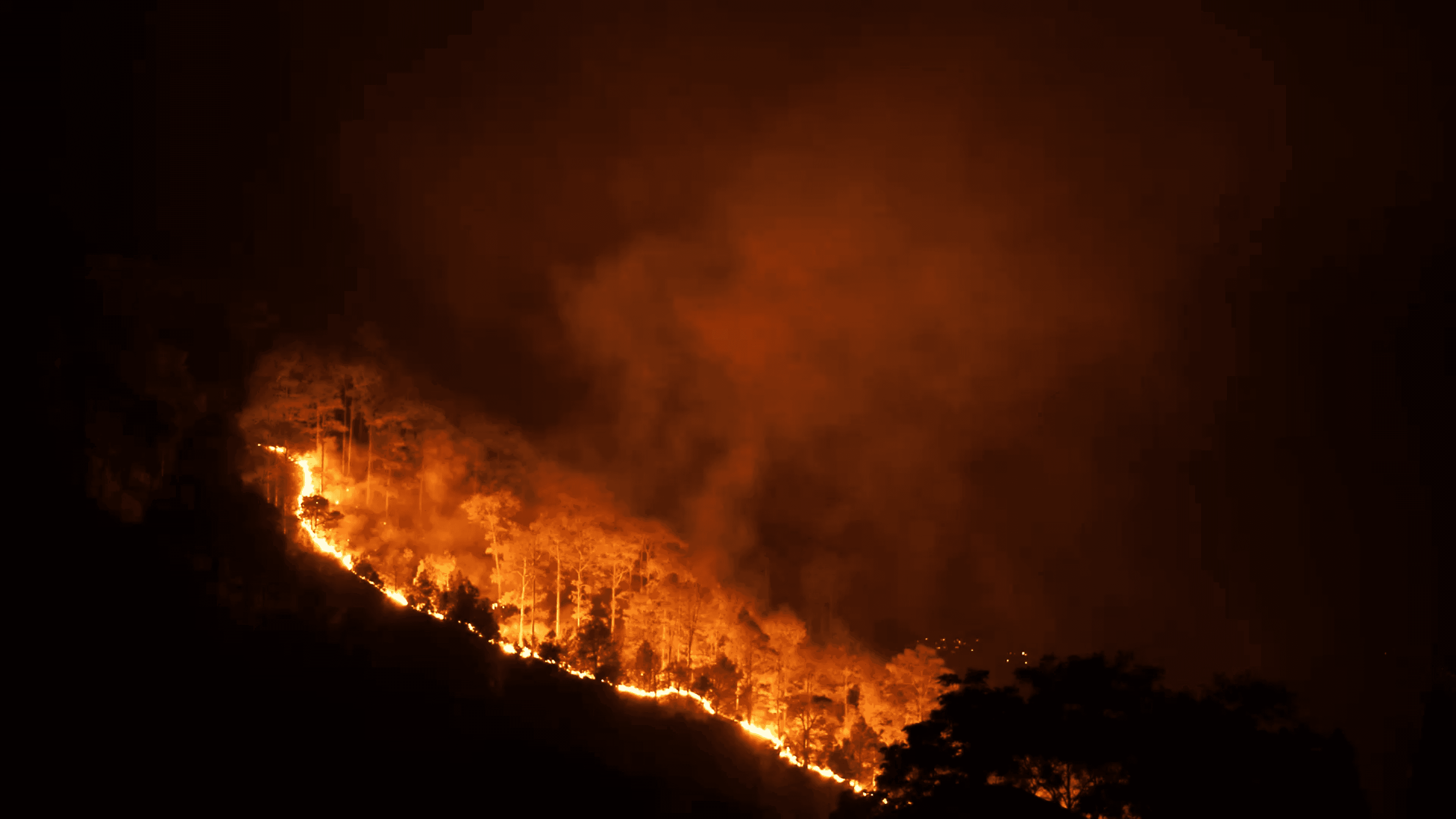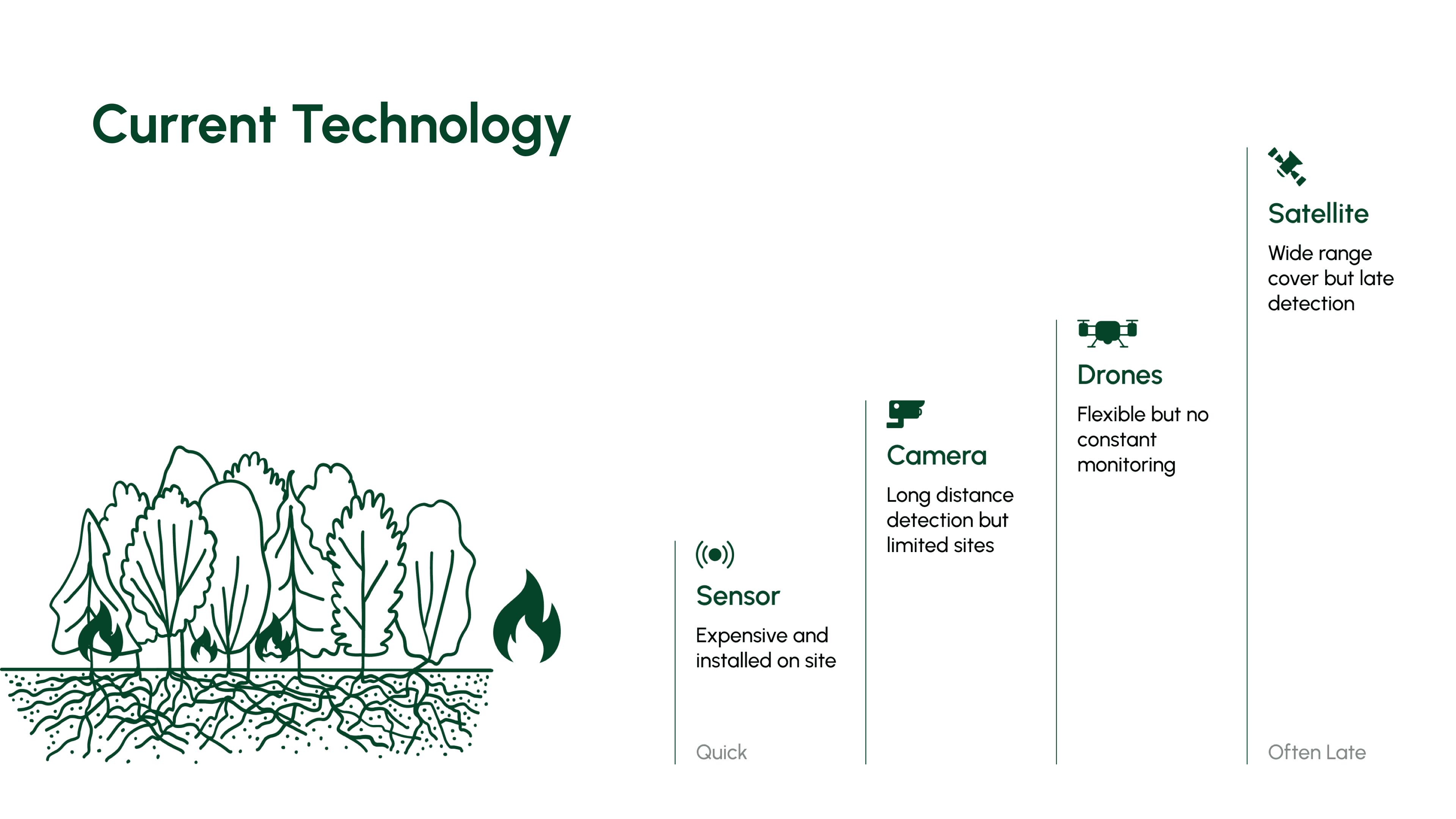Pyri
2023
Climate Tech. System Design. Product Design
Project Duration
3 Months · Master Group Project
My Roles
Industrial Designer, Design Engineer
Goal
Developing early wildfire detection solutions with sustainable approaches
2023
Climate Tech. System Design. Product Design
Project Duration
3 Months · Master Group Project
My Roles
Industrial Designer, Design Engineer
Goal
Developing early wildfire detection solutions with sustainable approaches
Pyri is an early wildfire detection system designed for remote communities. Powered by natured-inspired mechanism and materials, Pyri offers an affordable, easy to deploy and high coverage option to tackle the increasing risk of wildfire worldwide.

Pyri
2023
Climate Tech. System Design. Product Design
Project Duration
3 Months · Master Group Project
My Roles
Industrial Designer, Design Engineer
Goal
Developing early wildfire detection solutions with sustainable approaches
Pyri is an early wildfire detection system designed for remote communities. Powered by natured-inspired mechanism and materials, Pyri offers an affordable, easy to deploy and high coverage option to tackle the increasing risk of wildfire worldwide.
Context
Climate change is increasing the frequency and severity of wildfires globally. By 2100, extreme wildfires are predicted to increase by 50%, most significantly in the Arctic and tropical forests where communities are severely unprepared. Early wildfire detection is key to reducing wildfire devastation.


50%
Increase of wildfire risk by 2100 due to climate change
Elevated increase prediction from the UN Environment Programme
Areas new to wildfire globally is increasing


3mi
Km² to burn
50bi
Spent in USD
What wildfire caused in 2023


Challenge
The current wildfire detection system operates on a Swiss-cheese model, where each layer has inherent flaws. For instance, satellites can monitor vast areas but only detect fires once they have escalated to a large scale. Conversely, ground sensors are effective at early fire detection but are limited by their coverage area and require substantial time, money, and labor for installation and maintenance.


How can we detect wildfire as early as possible with sustainable and reliable approaches?
Concept
Inspired by pine cones, which release seeds only in the presence of fire, Pyri is a novel heat-triggered detection mechanism made from nature-derived materials in harmony with the environment they protect.


Pyri System
Pyri is designed with its full lifecycle in mind. Its fire detection sensors, PyriPods, can be easily distributed by helicopter or volunteers without installation. They detect fires using a heat-triggered mechanism and cross-reference satellite and weather data to reduce false positives. After fire, PyriPods, made from nature-derived materials, leave no environmental pollution.


How PyriPod Works
When a wildfire starts, heat triggers the PyriPod which then sends a warning signal over several kms to existing communication towers.


Process
We initiated our project with extensive primary research, interviewing more than 20 wildfire experts and community members from various regions. In the technical exploratory phase, we experimented with several wildfire detection factors such as lightning, smoke, heat, and infrasound. We then refined our concepts, tested new composite materials, and validated our designs for power generation, signal transmission, and radio communication, culminating in a patent application for these innovative technologies.


Technical Exploration
We developed our own power unit using salt water and aluminium-air battery and antenna made of customised charcoal composite. A range of tests were conducted including a bench test with fire where our the wax barrier melt and successfully act as a heat-trigger mechanism.
Team
I am immensely grateful to my teammates for their dedicated collaboration during our project, which included months of intensive brainstorming, spirited debates, and constructive challenges. Their unwavering commitment to advancing our idea for competitions and grants has been crucial. As innovation designers with diverse backgrounds, each of us contributes unique strengths that synergise seamlessly. This project wouldn’t have been possible without Blake, Karina, and Richard. A huge thank you to all of you!




Context
Climate change is increasing the frequency and severity of wildfires globally. By 2100, extreme wildfires are predicted to increase by 50%, most significantly in the Arctic and tropical forests where communities are severely unprepared. Early wildfire detection is key to reducing wildfire devastation.


50%
Increase of wildfire risk by 2100 due to climate change
Elevated increase prediction from the UN Environment Programme
Areas new to wildfire globally is increasing


3mi
Km² to burn
50bi
Spent in USD
What wildfire caused in 2023


Challenge
The current wildfire detection system operates on a Swiss-cheese model, where each layer has inherent flaws. For instance, satellites can monitor vast areas but only detect fires once they have escalated to a large scale. Conversely, ground sensors are effective at early fire detection but are limited by their coverage area and require substantial time, money, and labor for installation and maintenance.


How can we detect wildfire as early as possible with sustainable and reliable approaches?
Concept
Inspired by pine cones, which release seeds only in the presence of fire, Pyri is a novel heat-triggered detection mechanism made from nature-derived materials in harmony with the environment they protect.


Pyri System
Pyri is designed with its full lifecycle in mind. Its fire detection sensors, PyriPods, can be easily distributed by helicopter or volunteers without installation. They detect fires using a heat-triggered mechanism and cross-reference satellite and weather data to reduce false positives. After fire, PyriPods, made from nature-derived materials, leave no environmental pollution.


How PyriPod Works
When a wildfire starts, heat triggers the PyriPod which then sends an warning signal over several kms to existing communication towers.


Technical Exploration
We developed our own power unit using salt water and aluminium-air battery and antenna made of customised charcoal composite. A range of tests were conducted including a bench test with fire where our the wax barrier melt and successfully act as a heat-trigger mechanism.
Process
We initiated our project with extensive primary research, interviewing more than 20 wildfire experts and community members from various regions. In the technical exploratory phase, we experimented with several wildfire detection factors such as lightning, smoke, heat, and infrasound. We then refined our concepts, tested new composite materials, and validated our designs for power generation, signal transmission, and radio communication, culminating in a patent application for these innovative technologies.


Team
I am immensely grateful to my teammates for their dedicated collaboration during our project, which included months of intensive brainstorming, spirited debates, and constructive challenges. Their unwavering commitment to advancing our idea for competitions and grants has been crucial. As innovation designers with diverse backgrounds, each of us contributes unique strengths that synergise seamlessly. This project wouldn’t have been possible without Blake, Karina, and Richard. A huge thank you to all of you!




Pyri is an early wildfire detection system designed for remote communities. Powered by natured-inspired mechanism and materials, Pyri offers an affordable, easy to deploy and high coverage option to tackle the increasing risk of wildfire worldwide.
Pyri
2023
Climate Tech. System Design. Product Design
Project Duration
3 Months · Master Group Project
My Roles
Industrial Designer, Design Engineer
Goal
Developing early wildfire detection solutions with sustainable approaches


Context
Climate change is increasing the frequency and severity of wildfires globally. By 2100, extreme wildfires are predicted to increase by 50%, most significantly in the Arctic and tropical forests where communities are severely unprepared. Early wildfire detection is key to reducing wildfire devastation.


50%
Increase of wildfire risk by 2100 due to climate change
Elevated increase prediction from the UN Environment Programme
Areas new to wildfire globally is increasing


3mi
Km² to burn
50bi
Spent in USD
What wildfire caused in 2023


Challenge
The current wildfire detection system operates on a Swiss-cheese model, where each layer has inherent flaws. For instance, satellites can monitor vast areas but only detect fires once they have escalated to a large scale. Conversely, ground sensors are effective at early fire detection but are limited by their coverage area and require substantial time, money, and labor for installation and maintenance.


How can we detect wildfire as early as possible with sustainable and reliable approaches?
Concept
Inspired by pine cones, which release seeds only in the presence of fire, Pyri is a novel heat-triggered detection mechanism made from nature-derived materials in harmony with the environment they protect.


Pyri System
Pyri is designed with its full lifecycle in mind. Its fire detection sensors, PyriPods, can be easily distributed by helicopter or volunteers without installation. They detect fires using a heat-triggered mechanism and cross-reference satellite and weather data to reduce false positives. After fire, PyriPods, made from nature-derived materials, leave no environmental pollution.


How PyriPod Works
When a wildfire starts, heat triggers the PyriPod which then sends an warning signal over several kms to existing communication towers.


Process
We initiated our project with extensive primary research, interviewing more than 20 wildfire experts and community members from various regions. In the technical exploratory phase, we experimented with several wildfire detection factors such as lightning, smoke, heat, and infrasound. We then refined our concepts, tested new composite materials, and validated our designs for power generation, signal transmission, and radio communication, culminating in a patent application for these innovative technologies.


Technical Exploration
We developed our own power unit using salt water and aluminium-air battery and antenna made of customised charcoal composite. A range of tests were conducted including a bench test with fire where our the wax barrier melt and successfully act as a heat-trigger mechanism.
Team
I am immensely grateful to my teammates for their dedicated collaboration during our project, which included months of intensive brainstorming, spirited debates, and constructive challenges. Their unwavering commitment to advancing our idea for competitions and grants has been crucial. As innovation designers with diverse backgrounds, each of us contributes unique strengths that synergise seamlessly. This project wouldn’t have been possible without Blake, Karina, and Richard. A huge thank you to all of you!



